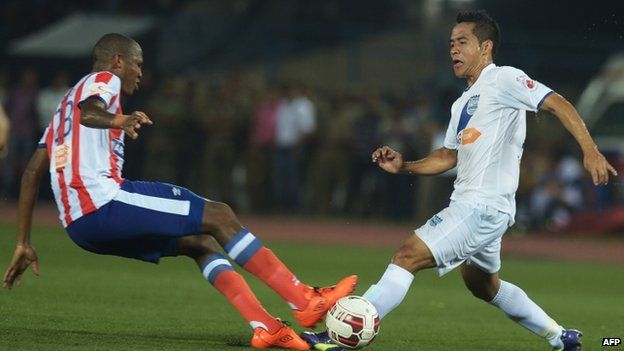Media: Indian Super League a 'lifeline to football'
- Published

Media feel the start of the Indian Super League (ISL) is likely to inspire more people to play the "beautiful game" in the country.
Hosts Atletico de Kolkata beat Mumbai City 3-0 in the opening game of India's new football league on Sunday night.
The game was played after a glittering opening ceremony involving legendary cricketers Sachin Tendulkar, Saurav Ganguly and top Bollywood stars.
Eight teams based in different Indian cities will play in the 10-week tournament with the aim of increasing the popularity of the sport in a "cricket-crazy" country.
"ISL can be considered as a lifeline to football... Why? Through the grassroots development programme through the league and the interest generated among the youth, it is likely to inspire many kids to hang up their cricket pads and pump the old deflated football, lying ignored in the attic," says the Deccan Chronicle.
However, other paper feel that the tournament has a long way to go before it can be described as a success.
And their worries are partly down to "the gulf" that exists between the quality of Indian and foreign players.
"Sunday's match proved - if at all it was warranted - that world football's ageing A-listers and beleaguered B-listers are still better than their Indian counterparts who are at the peak of their careers," says The Indian Express.
But The Times of India feels that the presence of foreign players will help Indian footballers learn more about the game.
"Nobody is fooled into believing change will happen overnight. The unmatched focus on youth development from each franchise also means, beyond the glitz and glamour, there is enough even if you scratch the surface," it adds.
Jaffna rail link
Moving on to other news, papers are praising officials for taking "pre-emptive evacuation measures" to minimise the loss of life before Cyclone Hudhud pounded the eastern Indian coast.
At least three people have been killed in Andhra Pradesh and three in Orissa state.
The Hindu says that the cyclone caused "extensive devastation" to physical infrastructure, but authorities in the two states had evacuated over 500,000 people to relief camps, limiting the number of deaths to six - a steep decline in casualty figures compared to earlier occasions.
"Though a few casualties have been reported, a historical analysis of fatality data shows that the life of an Indian stuck in the path of an oncoming cyclone is valued more today than even 10 years ago," another report in the paper says.
The Hindustan Times adds that the low casualty figures reflect "the progress technology and state preparedness have made since calamities like the tidal wave in 1977 in Krishna district [in Andhra Pradesh] and storm flood of Godavari [river] districts in 1996 claimed thousands of lives".
And finally, India's rail authorities have helped Sri Lanka restore an iconic railway line that connects the northern city of Jaffna with the capital, Colombo.
The rail link was destroyed and stopped functioning in 1990 at the height of an armed conflict between the rebel Tamil Tigers and government troops.
President Mahinda Rajapaksa is due to formally inaugurate the rail link on Monday, reports say.
India provided experts and financial assistance to help Sri Lanka restore the line, The Hindu reported.
The rail link will connect Sri Lanka's war-torn northern areas to the rest of the country.
BBC Monitoring reports and analyses news from TV, radio, web and print media around the world. For more reports from BBC Monitoring, click here. You can follow BBC Monitoring on Twitter and Facebook.